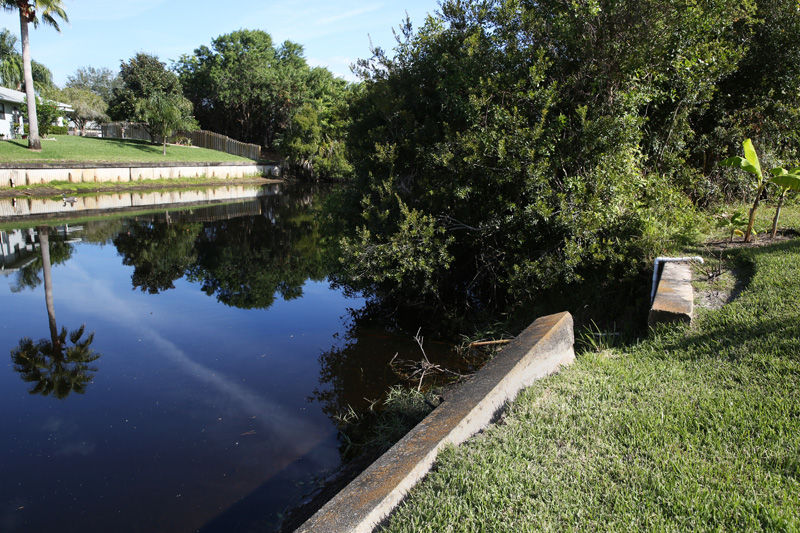SEBASTIAN — Although the situation isn’t quit as dire or widespread as originally thought, Sebastian still has a way to go to solve the problem of its failing seawalls and the 8-figure price tag the solution will likely carry.
After hearing a comprehensive, well-illustrated seawall assessment presentation by Hoyle, Tanner & Associates Aug. 26, City Council discussed the report at length, then passed the soggy mess back to City staff.
Approximately 61,000 linear feet of seawall were assessed, representing 601 homes on both sides of the waterways. Now that the extent of seawall damage along the nearly seven linear miles of the South Collier and George Street Canals and the Schumann and Elkham waterways are established; options and time frames for remedial action are developed; and costs are calculated, staff has been tasked with recommending what to do; how and when to do it; and – the elephant in the room – who’s going to pay for it.
Engineer Wilbur Mathurin told council that about 38% of the assessed canal banks do not have a seawall. Of the existing seawalls, most are concrete or metal, probably built by the original developer, in the 1980’s. The rest, likely constructed by homeowners, are of wood, vinyl or rip rap bags, and many are supplemented with earthen berms. In general, said Mathurin, seawalls surrounded by heavy vegetation appear to be in good condition.
Seawalls were graded in a 1-10 rating system, worst to best condition, within five categories, from failing to good. A dozen parcels, or 3% of the seawalls, were listed as failing, 1 or 2: two parcels along Joy Haven had the most critical rating – No. 1; the other 10 were rated No. 2: four along George Street; three along Schumann Drive; and three along Bailey Drive.
Of the remainder, 5% were poor, 3-4; and the rest were fair, 5-6, satisfactory, 7-8, or good, 9-10. Those considered to be failing or poor, Mathurin said, should be restored as soon as possible, within a 0-2 year window. Those considered to be good would likely need to be addressed only after 15-20 years, and the others fell with that span.
The report offered three basic options, with work scheduled, based on seawall condition assessment, between 2017- 2035:
1. Construct new seawalls in front of existing seawalls. Pricetag – $15.8 million.
2. Remove and replace existing seawalls. Pricetag – $23.8 million
3. Dredge soil from the canal and refill over the top of existing seawalls. Pricetag – $14.9 million.
Council member Jim Hill suggested a fourth option: Repair as needed, as individual seawalls fail, and said he’s “not even close to approving $15 million” if only 12 seawalls are currently critical. He inquired about the cost to repair just the 12. (based on the method chosen, it’d range between $400 and $800 per linear foot, according to the report, and most parcels are 80-100 LF.)
“To my way of thinking, whatever we do, any seawall is going to fail eventually,” said Mayor Richard Gillmor. “It’s eye-opening.“ He noted that, since about 40% of the canal system doesn’t even have seawalls, only sloping banks, which seem to be working well, perhaps entombing the seawalls in dirt when they fail would be the way to go.
Council member Andrea Coy wondered if there was any “secret” underlying reason why, of the 12 most critical seawalls, there seemed to be two “clusters.”
Hoyle, Tanner VP Doug Norman replied that, although there was no specific natural cause in those locations, homeowner practices such as planting palm trees or locating sprinkler systems close to seawalls can undermine the walls, and homes built with a high elevation (8-9 feet above the walls) can create additional pressure, (as can heavy equipment and even the pressure of a backyard swimming pool), all of which can compromise the seawalls’ integrity, and ultimately cause cracking, tipping or separating.
Gillmor suggested asking staff to provide options for 2017 – addressing the most critical seawalls – then come up with a “uniform vision, going forward.”
Hill agreed, stating the City could handle some of the cost burden if other money was also available, such as grant funds. City Engineer Frank Watanabe said the St. Johns River Water Management District has matching grants available and told Council he’ll pursue that funding avenue.
Coy commented that “this is only the beginning of the discussion,” and she expressed surprise that the homeowners with the most critically failing seawalls were not present. (A couple of these homeowners had threatened to sue the city last year, when a professional survey, obtained by the City, determined the seawalls associated with the homes were on private property and, therefore, the homeowner’s cost responsibility.)
The complete assessment report is available on the City’s website: cityofsebastian.org.

